Hitler's designers gave a strange name to the ingenious weapon they had created. The old myth came to the rescue, and the weapon acquired a name: "Mistel" - mistletoe. 
The Luftwaffe did not have long-range bombers: the Junkers-87-88, 188, Dornier-17, Heinkel-111, and Focke-Wulf-200 did not qualify for this title - their range was not impressive.
While the Germans were still able to carry out "blitzkriegs", this fact did not particularly bother them, but when it became clear that the war was dragging on, it turned out that there was nothing to bomb large targets deep behind enemy lines with.
And something had to be done about it. And quickly - without wasting time on developing a new aircraft.
The designers rushed to study world experience, and what did the enemy have? How to attack the enemy in the rear?
Britain and the USSR already had their own solutions. The mother plane delivered small planes to the target and they dealt with the enemy. And they had combat experience.
The baptism of fire of the "Zvena-SPB" took place on July 26, 1941. The task was given to bomb the oil storage facility in Constanta. Three TB-3s with six I-16 aircraft took off. The mission was successfully completed — the target was hit without losses. The enemy did not expect to see Soviet fighters. During the airstrike, the fighter-bombers detached from their carriers with their bomb load at a distance of 40 km from the target and after hitting the target, they returned to the airfield in Odessa, where they refueled and returned to Yevpatoria under their own power. 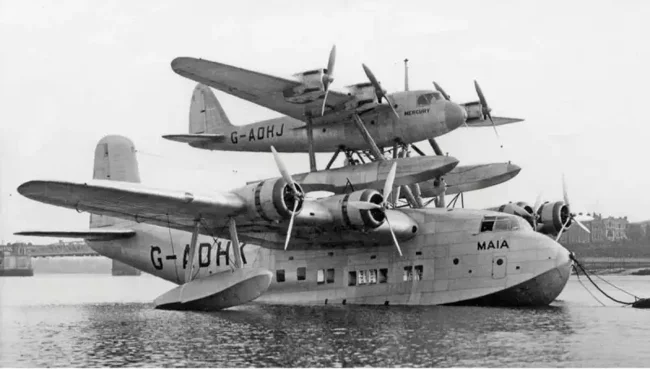
British twin: Short S.20 - Maya S-21 
I-16 under the wing. 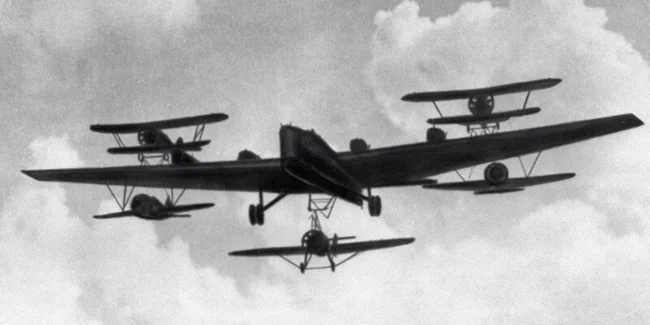
Aircraft carrier TB-3 
The gloomy Teutonic genius found his solution: what if you launch a bomber at an enemy target one way? That immediately doubles the range! The idea was suggested by test pilot Siegfried Holzbauer. Back in the 1930s, he participated in the testing of the English Short S.20 - Maya S.21 "Composite" twin: the Maya S.21 mother aircraft carried a Short S.20 "Mercury" seaplane on its back. The combination managed to achieve a world record for the flight range of seaplanes - 9,652 kilometers!
Goltsbauer proposed "reversing" the scheme: if previously the "parasite plane" reached the target, and the mother aircraft returned to the base, then here the one-way flight was made by the mother aircraft, and the pilot returned home on the "parasite".
The idea was as follows: a fighter is attached to the fuselage of the bomber, the pilot of which controls the "bundle". A cumulative or high-explosive warhead is installed in the bomber. The pilot leads the group in the direction of the target, then, at a certain distance from it, detaches and flies home. And the bomber continues to fly until it reaches the enemy target.
When Junkers engineers heard about this idea, they decided that they had never heard anything crazier. But! There was no time to develop a normal long-range bomber, so the idea was reported to the Ministry of Armaments. According to calculations, the plane-bomb could penetrate up to seven meters of concrete with its cumulative warhead, and any battleship was guaranteed to be sent to the bottom. In general, the military showed moderate interest in the project, and the work began to boil! 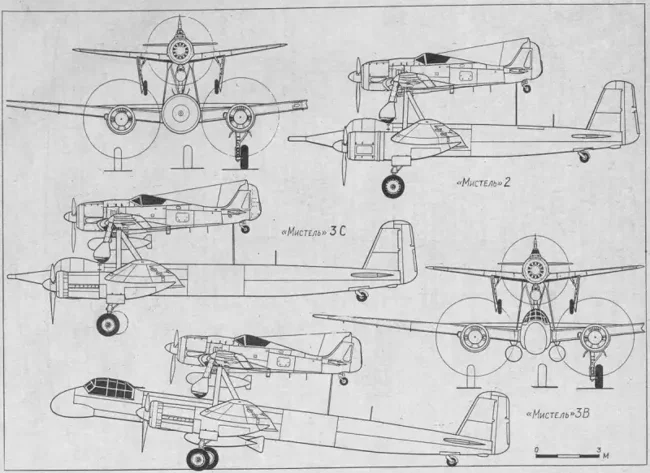
Fifteen pairs were built to begin with. The Ju-88A-4 was used as a carrier, and the Bf-109F-4 as a "parasite". Already in November 1943, the first "Mistelle" was tested against an old French target ship. The result was considered satisfactory. 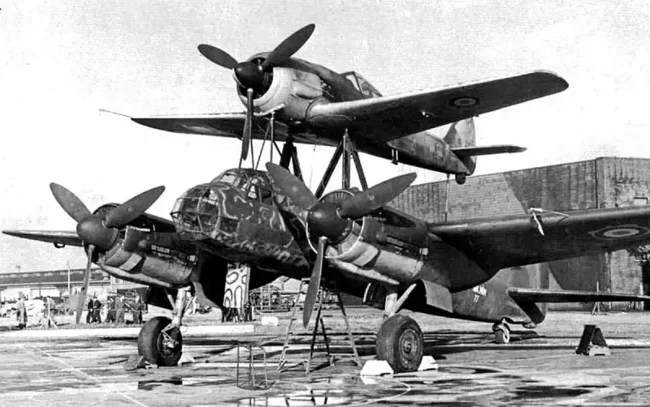
A variant of the "Mistel" with the FW-190A
There was no standard in the equipment of the twin-engines: they stuck to what was at hand. Therefore, various modifications of the Bf-109 and the FW-190A were used as "parasites", and various modifications of the Ju-88 were used as a carrier. Soon a squadron of "Mistels" was created - II/KG.200 "Beethoven". Later, Operation "Iron Hammer" was developed - raids on Soviet industry. But it was already 1945, and they decided to look for closer targets for the Mistletoe: Soviet crossings over the Oder, Vistula and Neisse. It turned out that the clumsy twin-engines were too good a target for fighters and anti-aircraft guns, and there were plenty of both in the frontline zone. 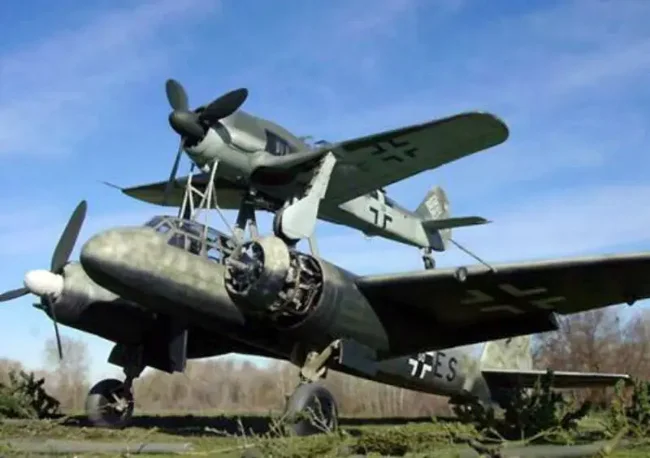
A miracle weapon that didn't work...
In general, the "Mistels" did not achieve any serious success. Right before the end of the war, projects for twin-engine aircraft based on jet aircraft appeared on the drawing boards: Ju-287/Me-262 or Ar-234/Ar E.377, but they never got beyond the drawing boards. In total, about 250 "Mistels" were produced by the end of the war.
Did this project have an impact on the course of the war? Zero.... 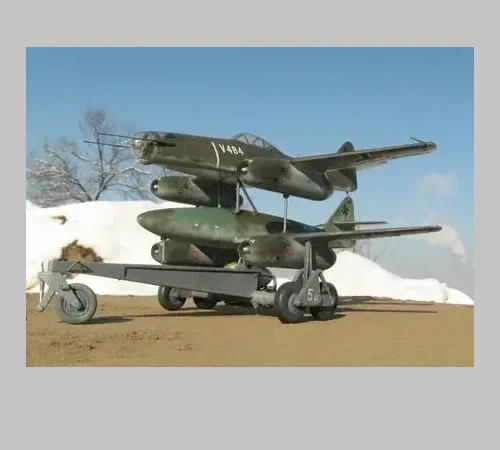
The jet "Mistel" never left the design stage.
And why was the project called "Mistletoe"? It was like this... Odin's son Balder was "the kindest, the wisest, the most honest, the strongest." He, being an immortal god, was very afraid of death (a strange fear for an immortal), which he saw in a dream, which he told his mother, Odin's wife, Frigg, about. She took her son's dream seriously and took an unbreakable oath from all objects in the world - living and non-living - that they would not harm Balder. She missed only the mistletoe: looking at its frail shoot, Frigg decided that it could not harm her son anyway.
The trick worked: now not a single object in the world could harm Balder, which he and his friends immediately took advantage of. The young idiot gods immediately began throwing everything they could get their hands on at Baldr, laughing loudly as spears, swords, and arrows, as well as hammers, anvils, and other household tools, bounced off the invulnerable son of Odin.
Naturally, this did not please the treacherous Loki, who, disguised as a servant, decided to pry the oath out of Frigg: from whom was the oath not taken? And he found out that the mistletoe shoot had promised nothing to anyone. That was the end of Baldr: Loki tore off the shoot, made an arrow out of it, and gave it to the blind god of fate, Hod, with whom no one played (he was blind!). Hod happily agreed and stabbed Baldr with a cold polearm made of mistletoe, from which he died.
That is, any strongman and giant can be killed if you poke him with what you need and where you need... 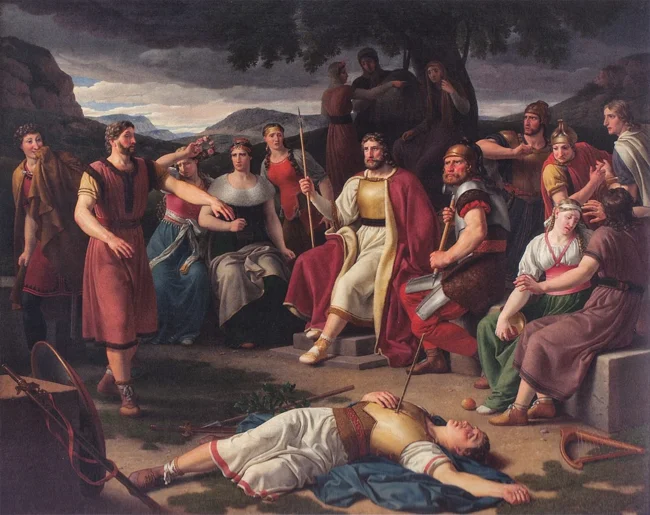
Add your comment
You might be interested in:






















